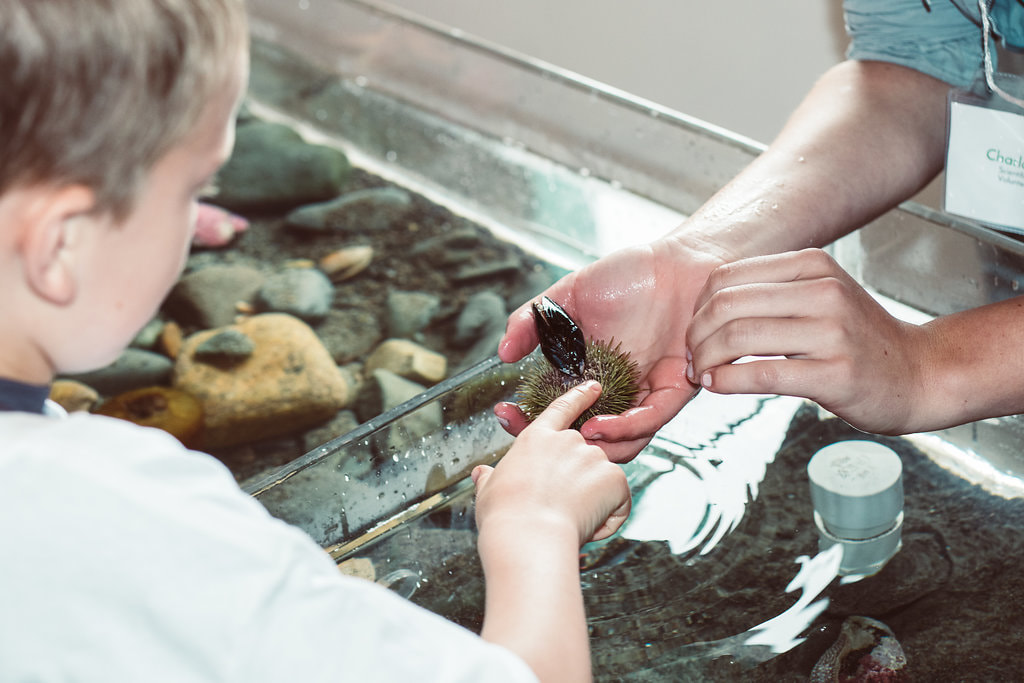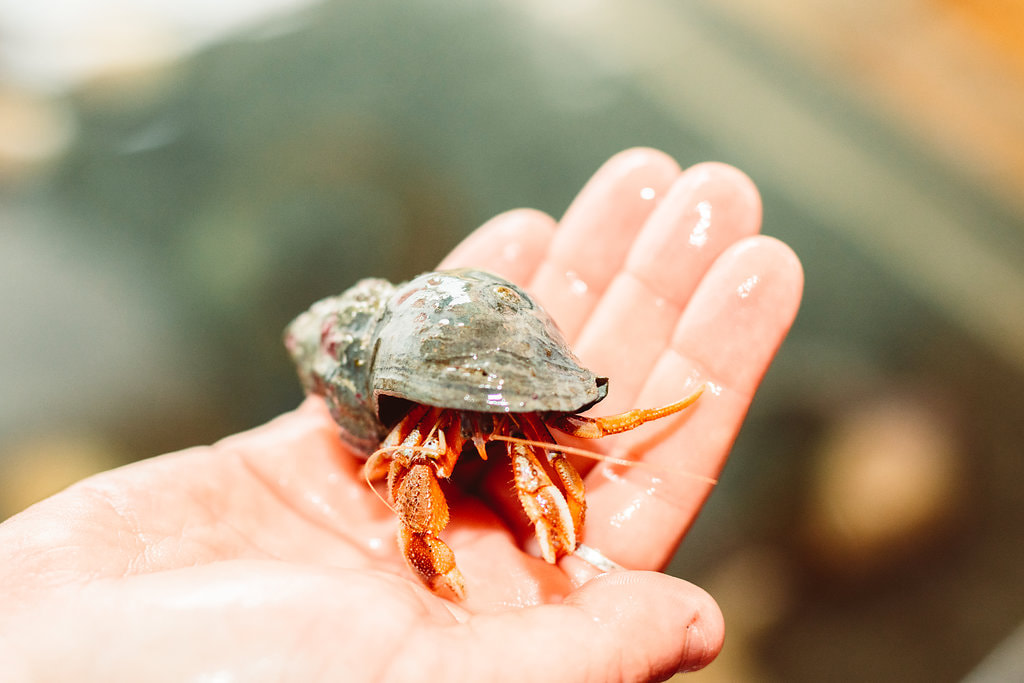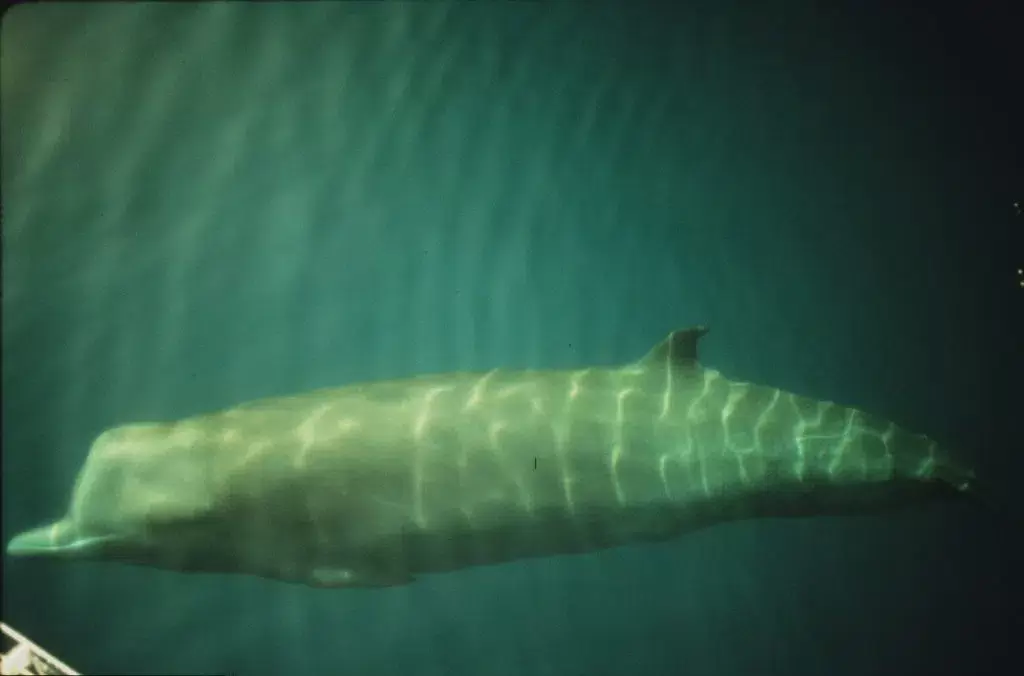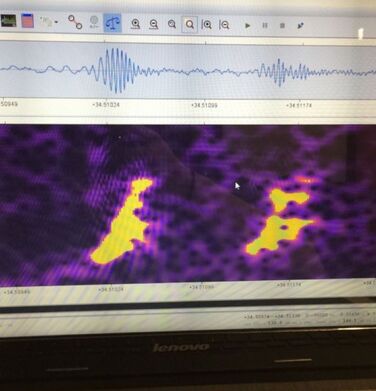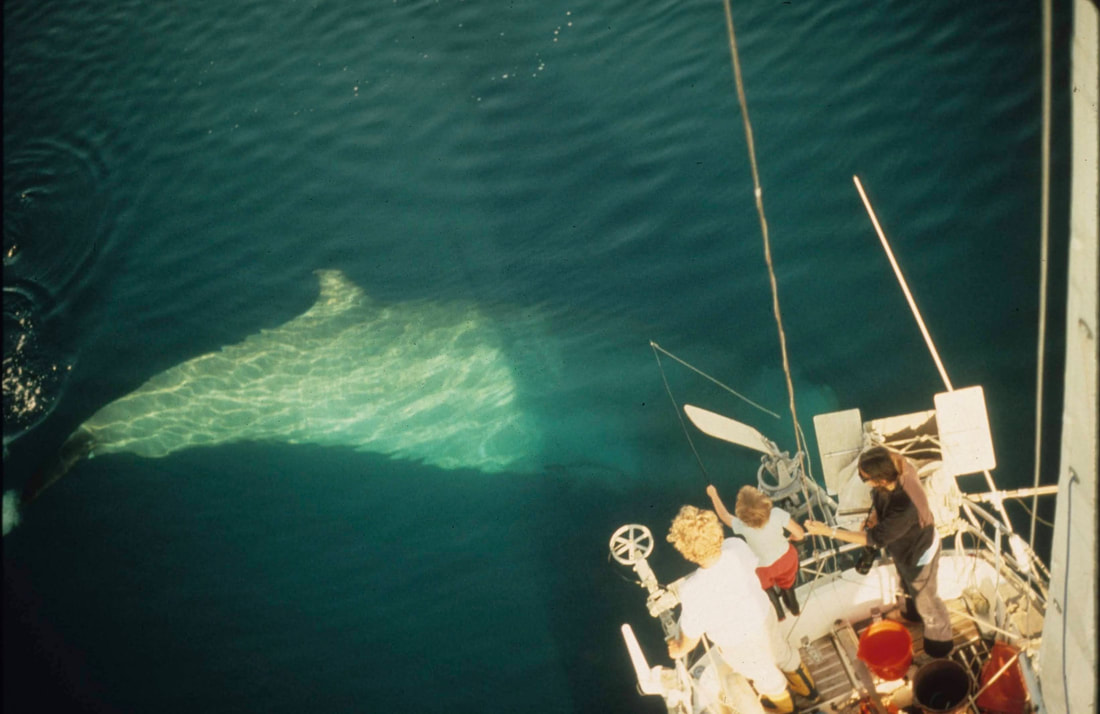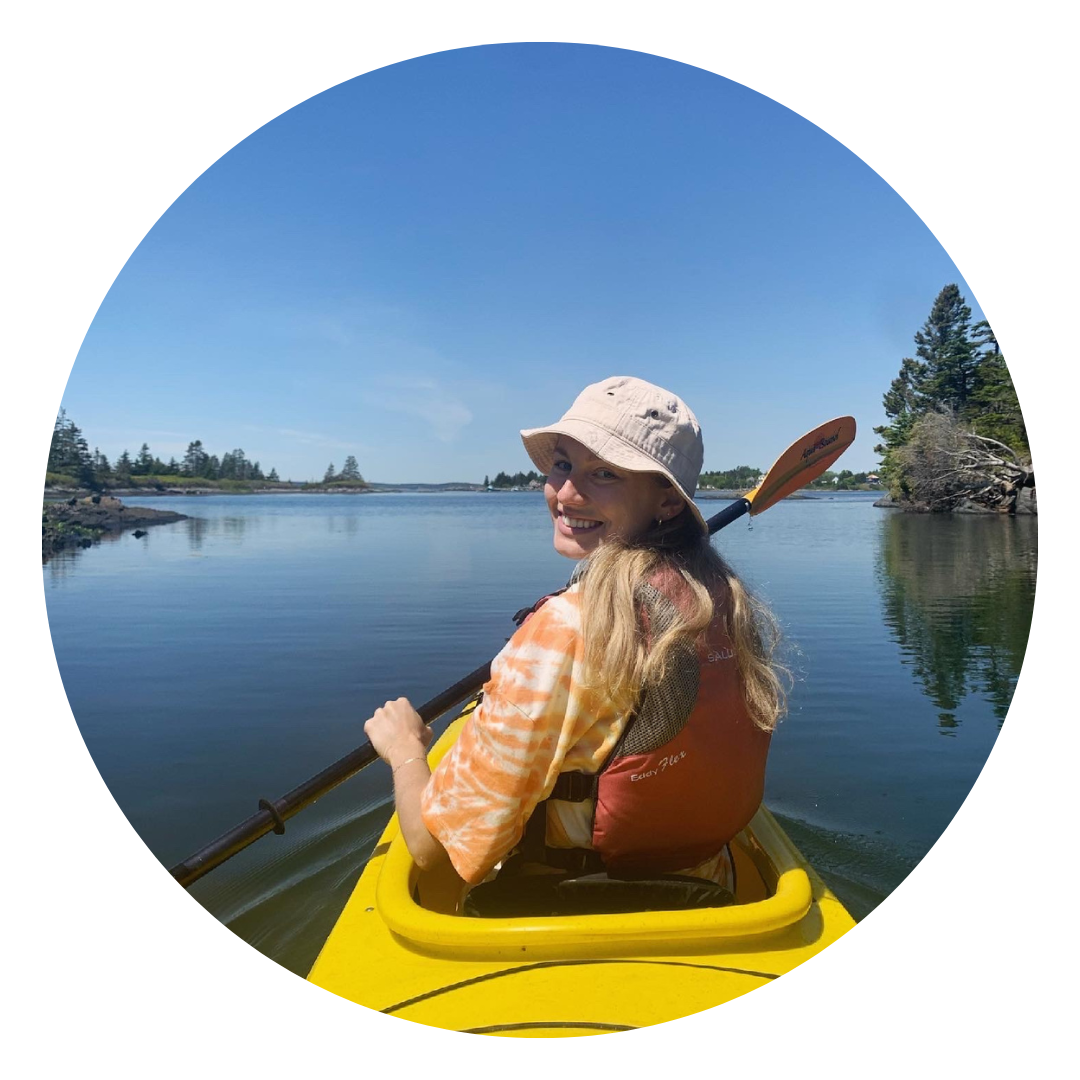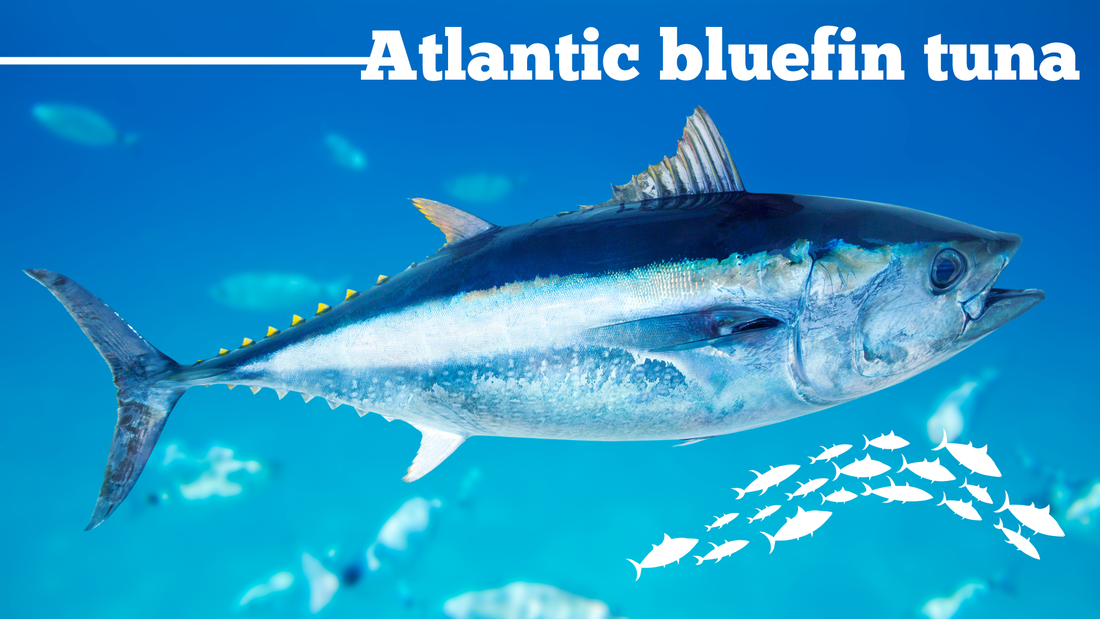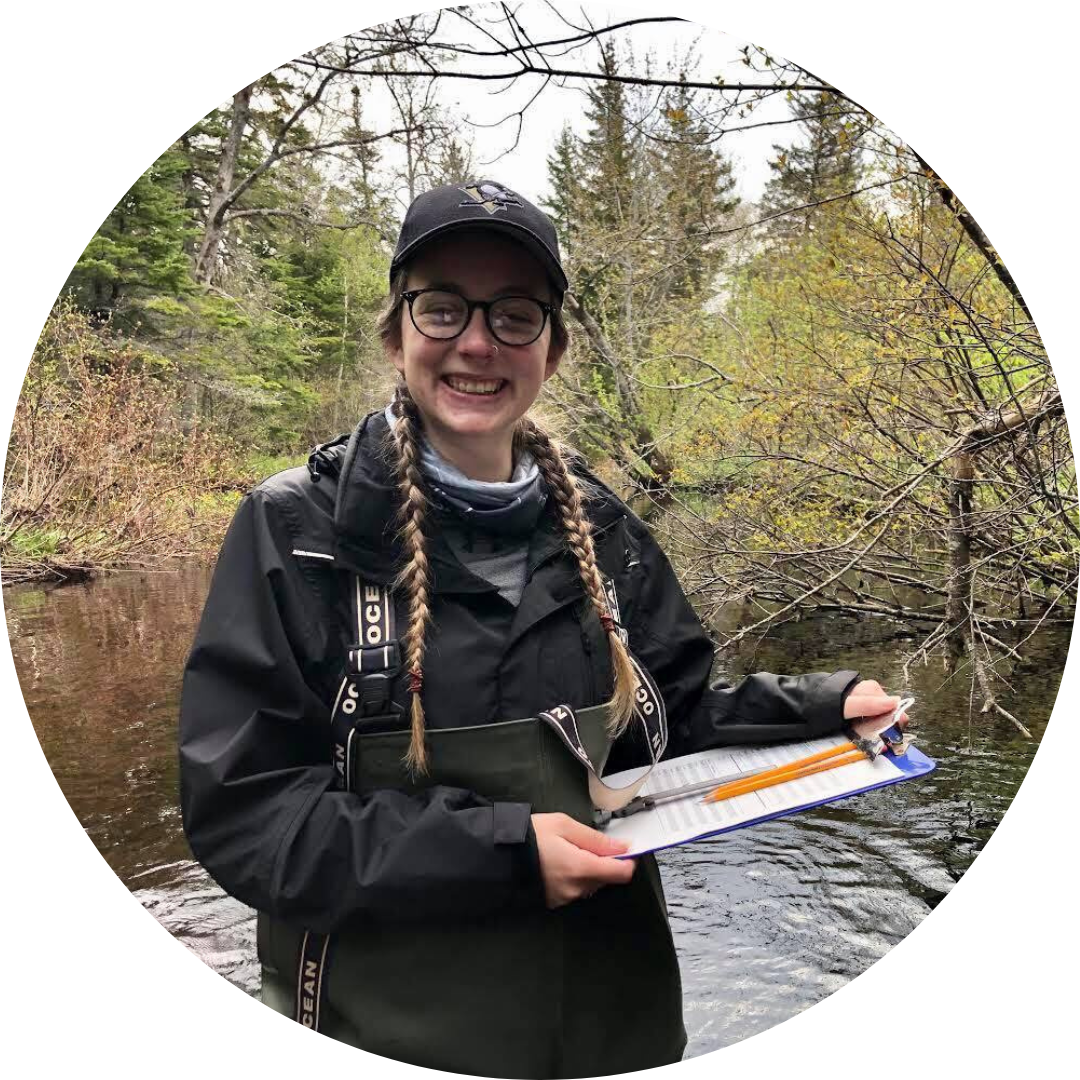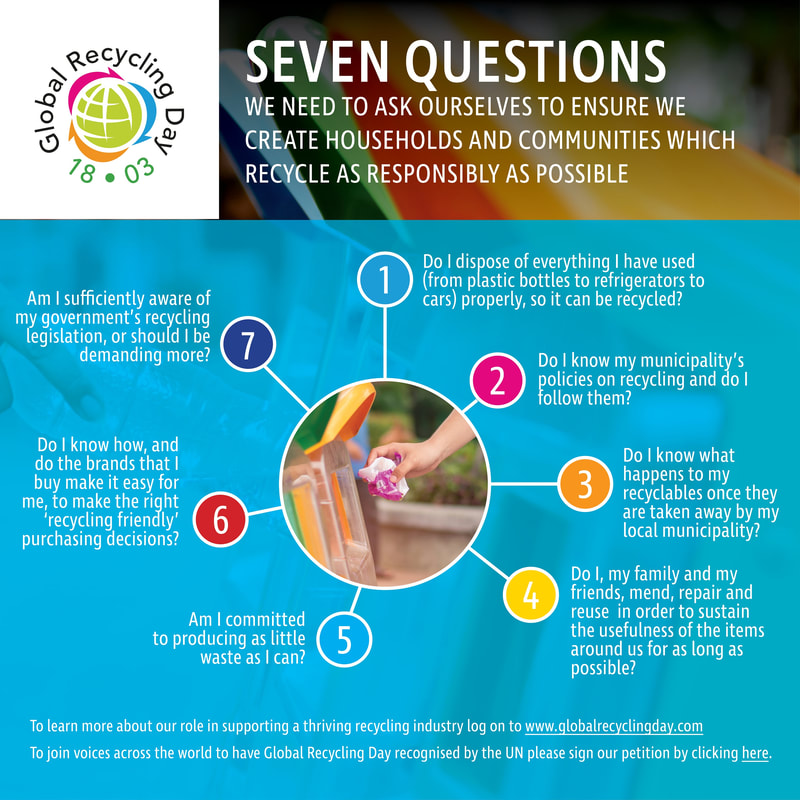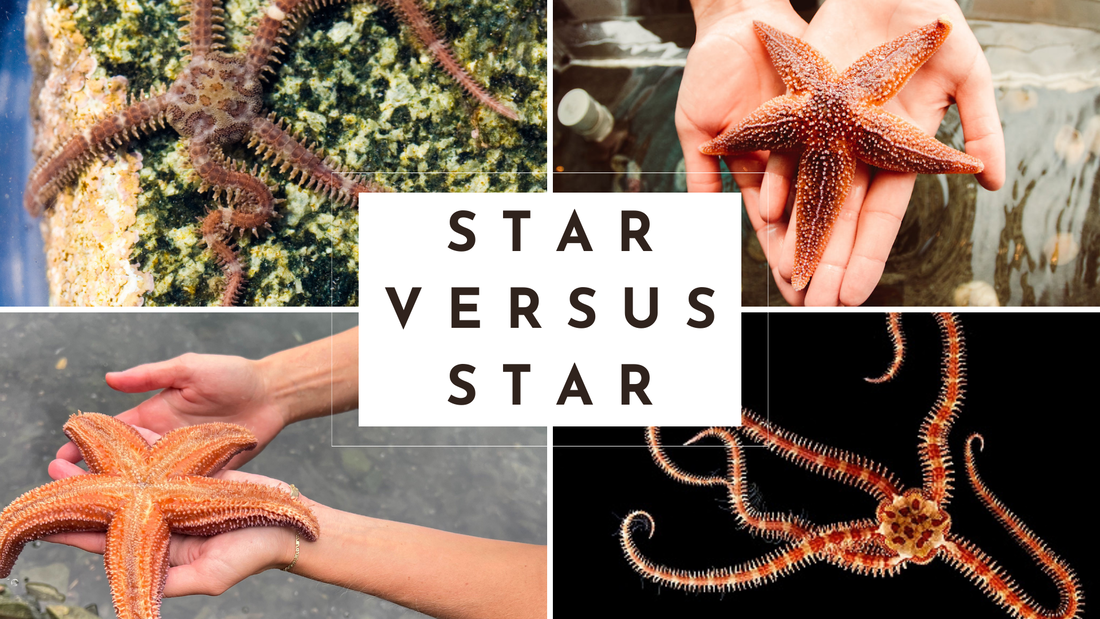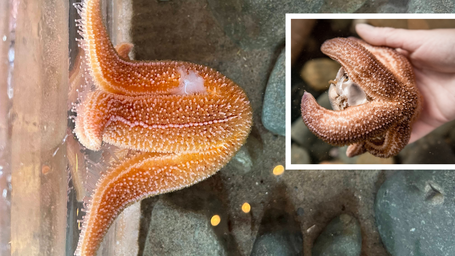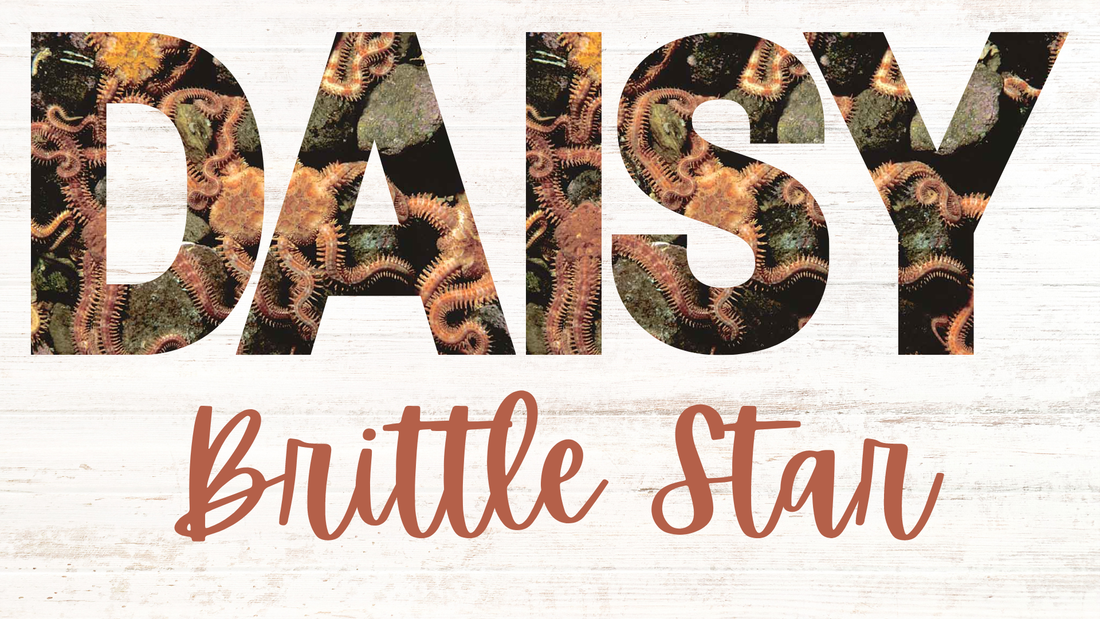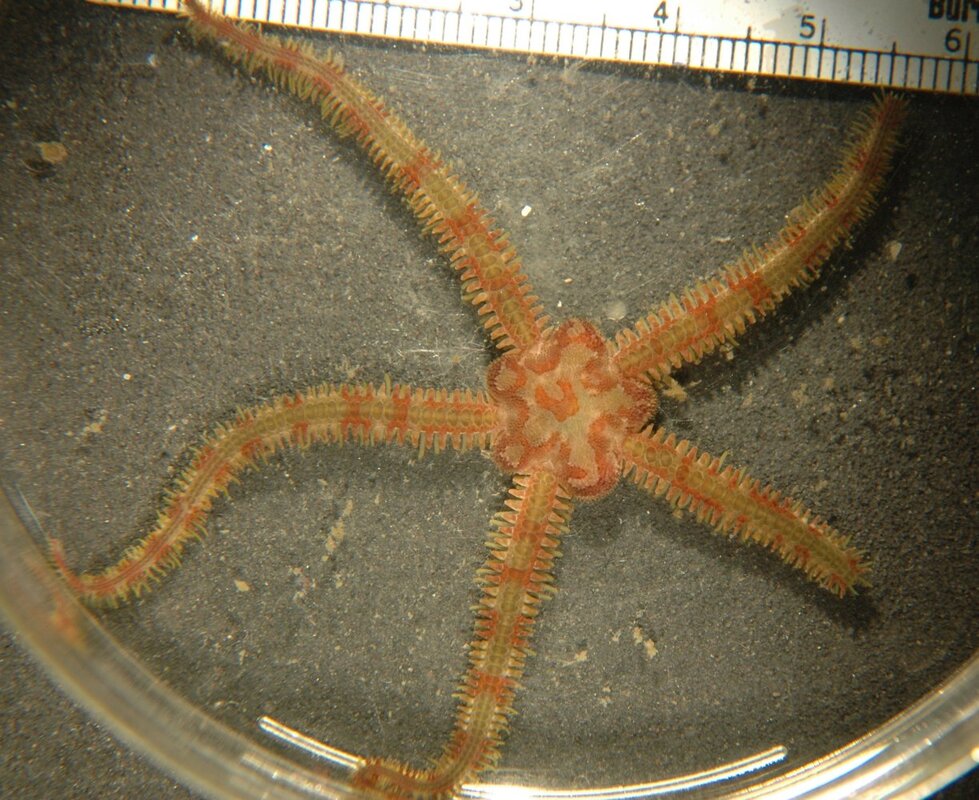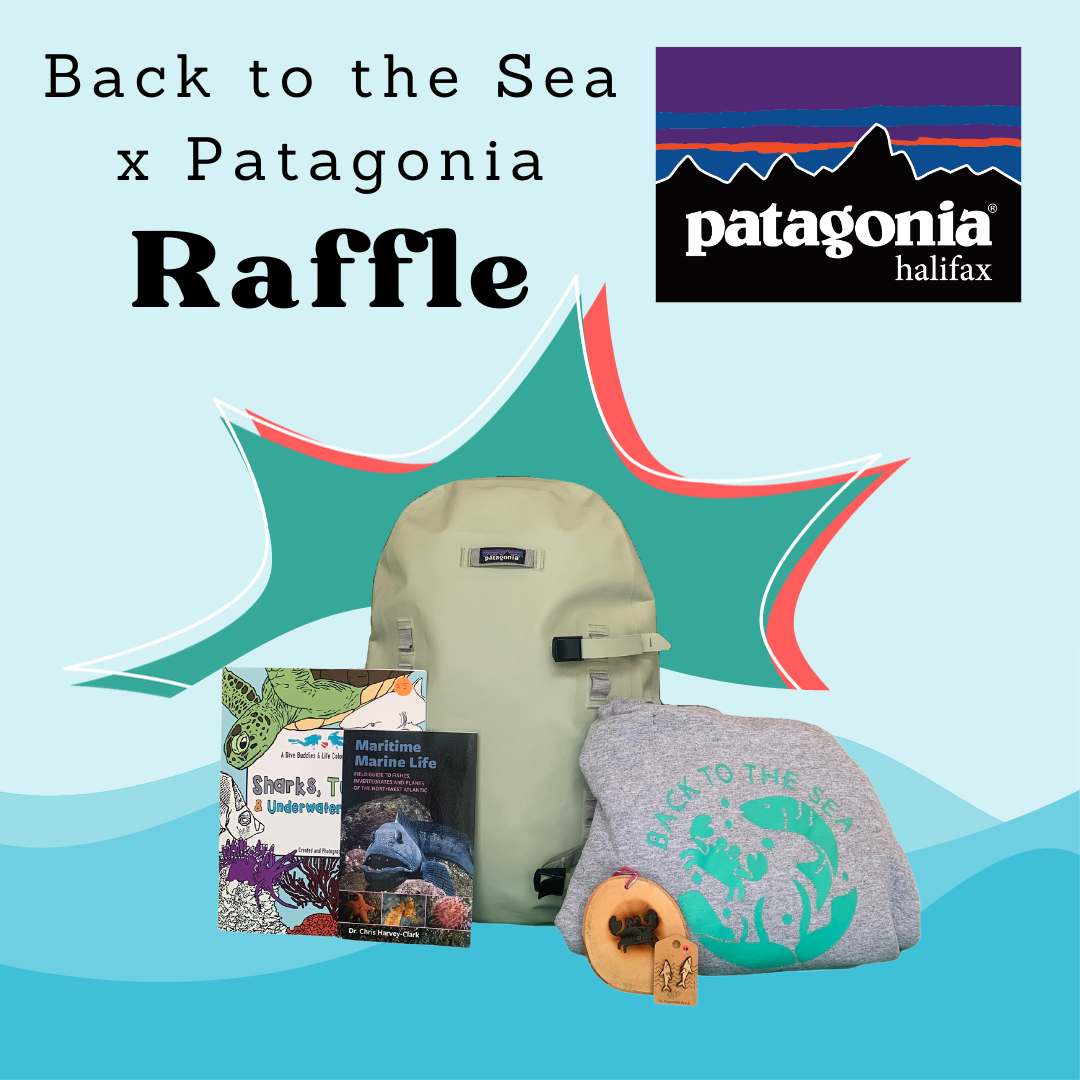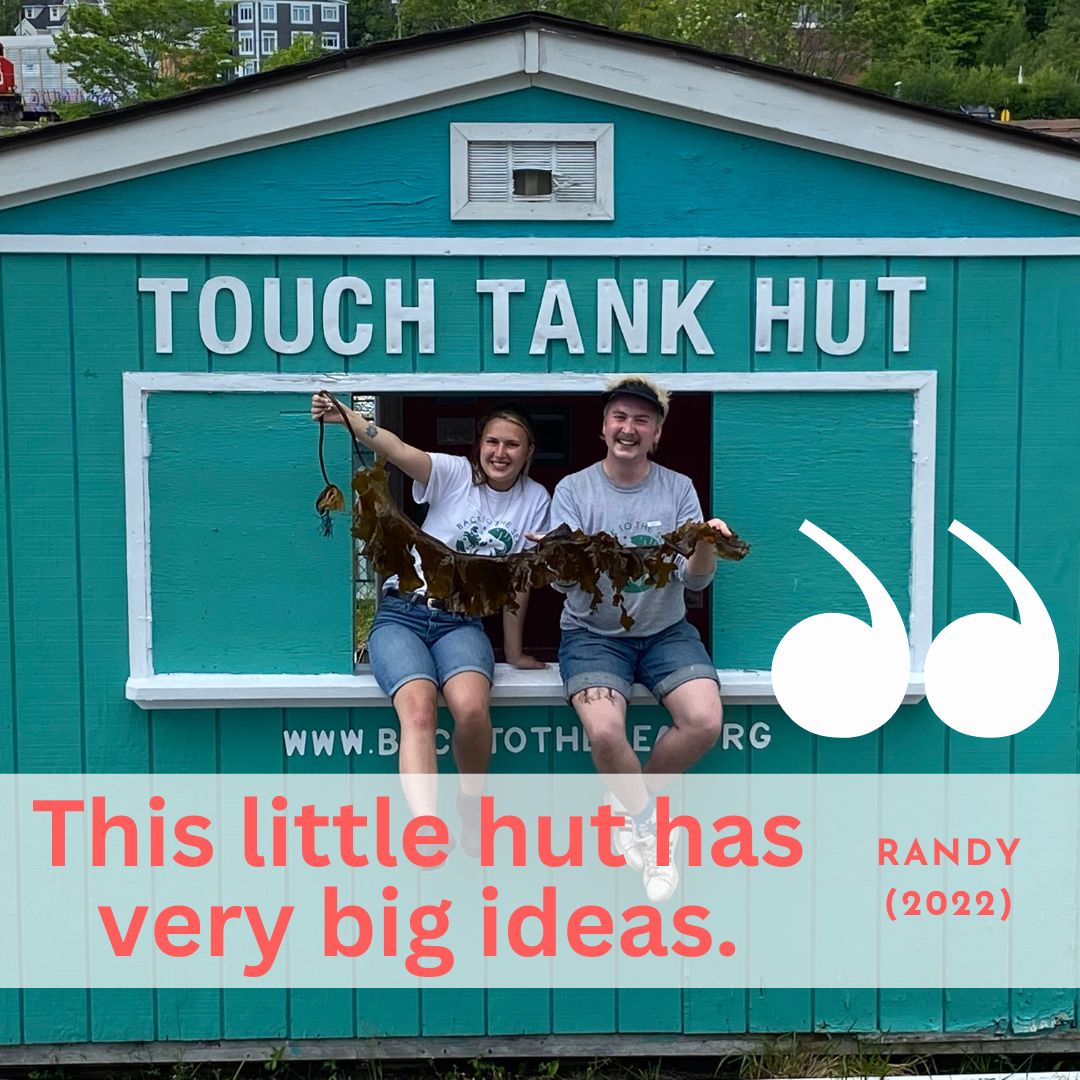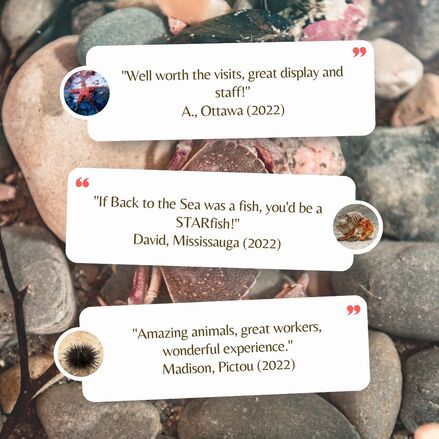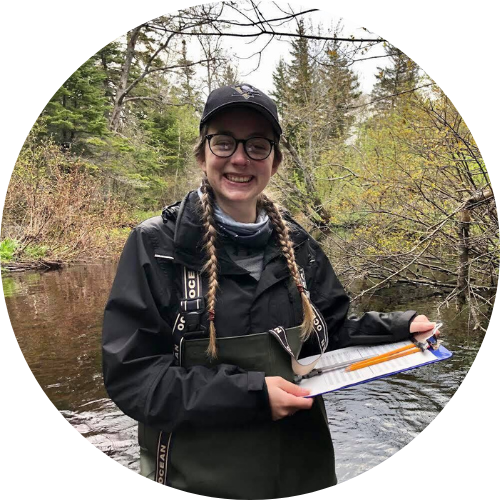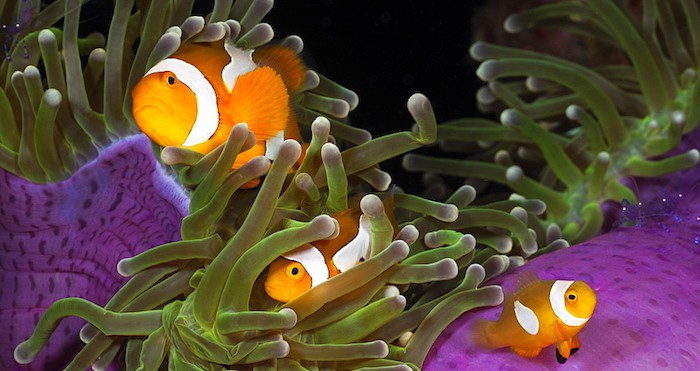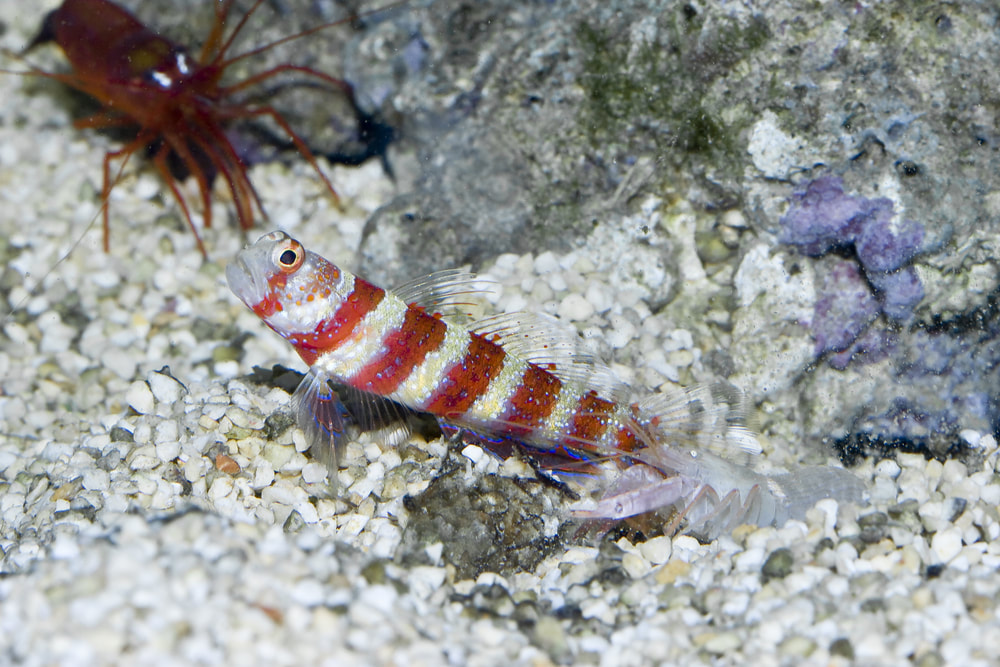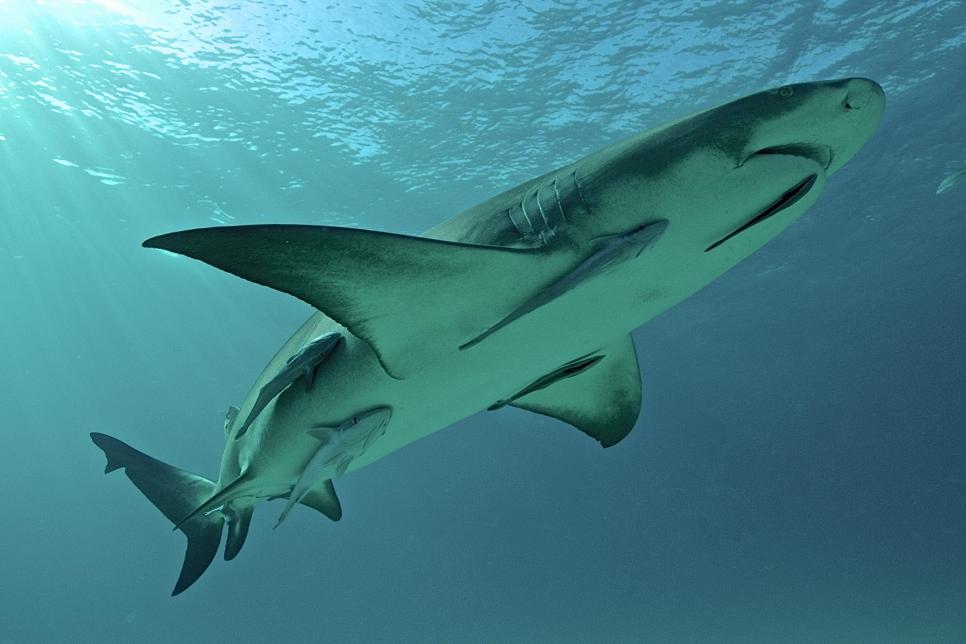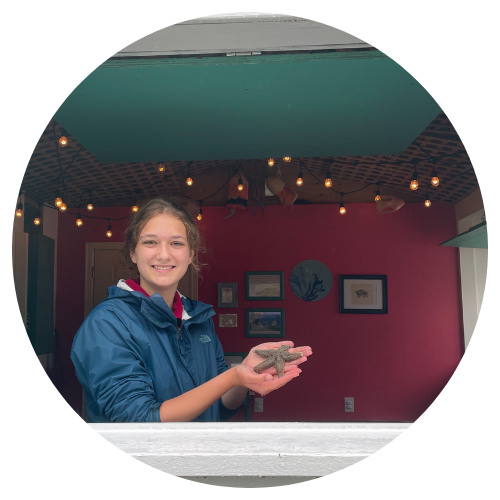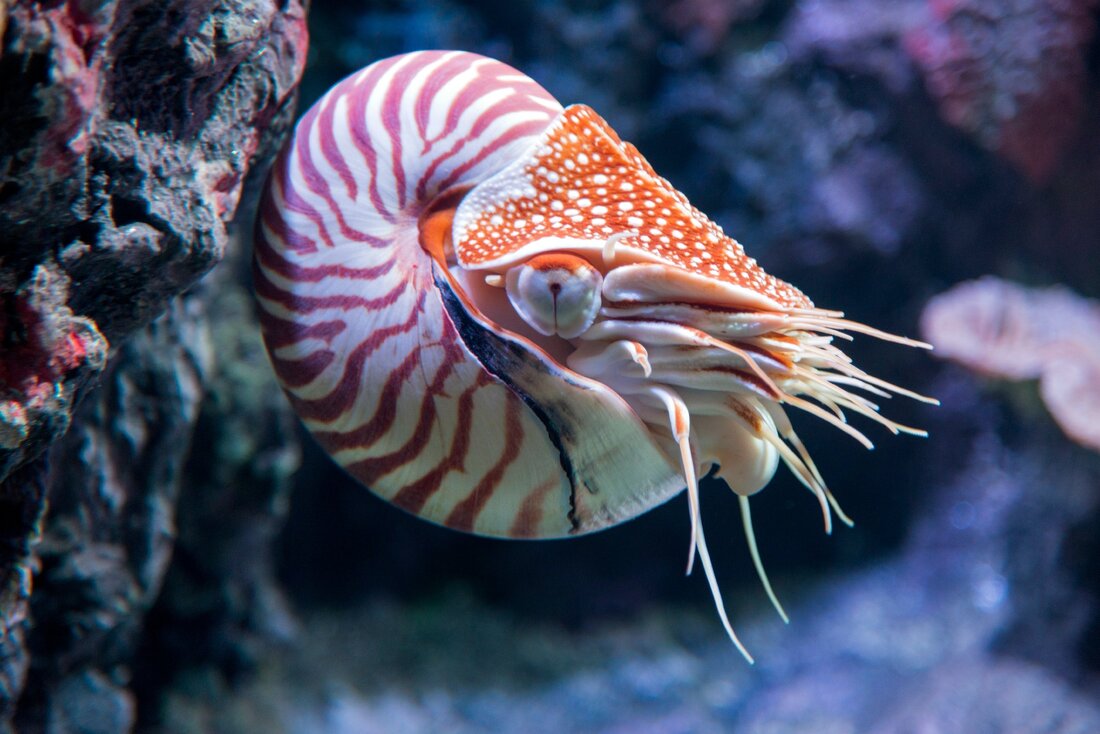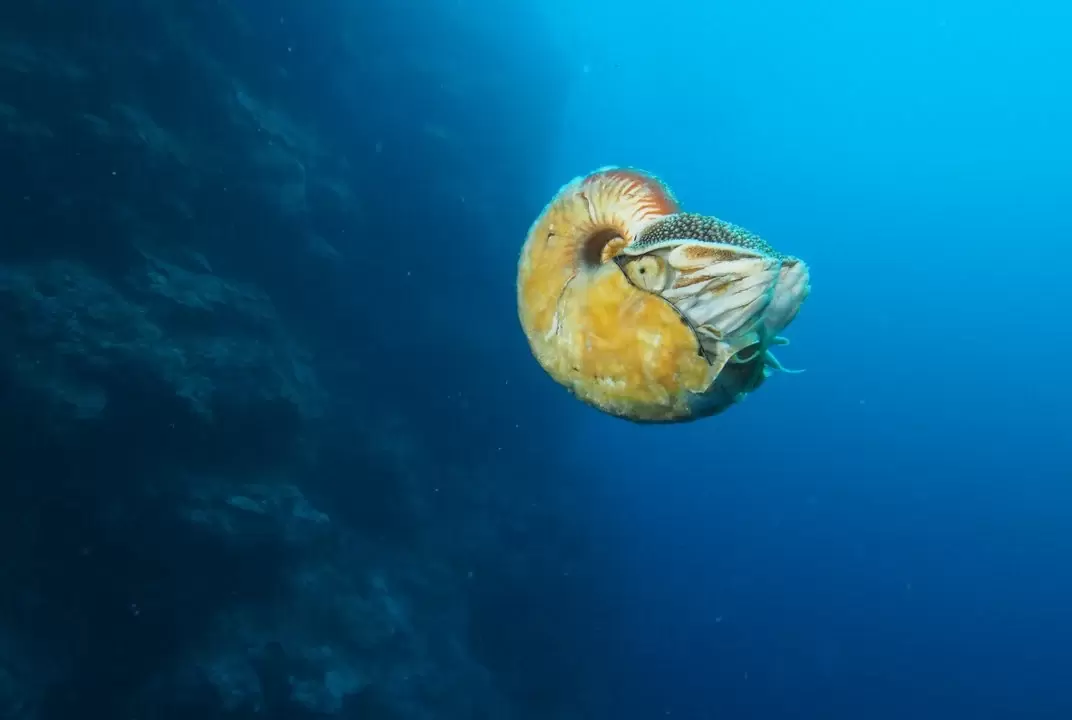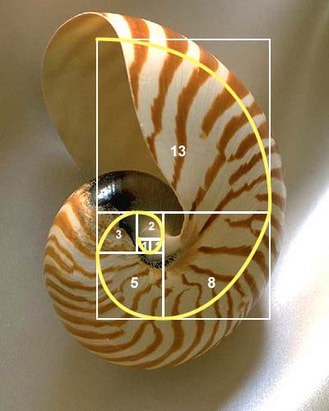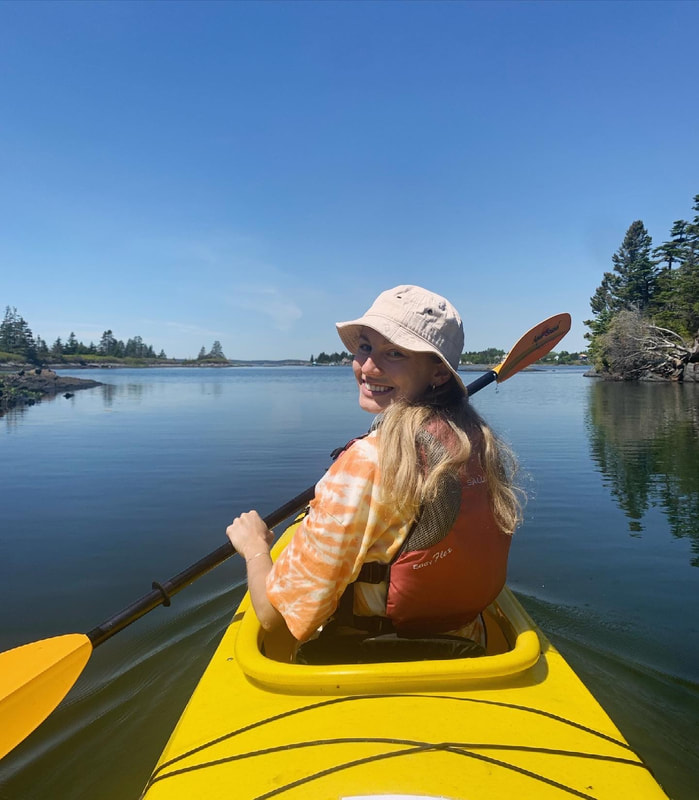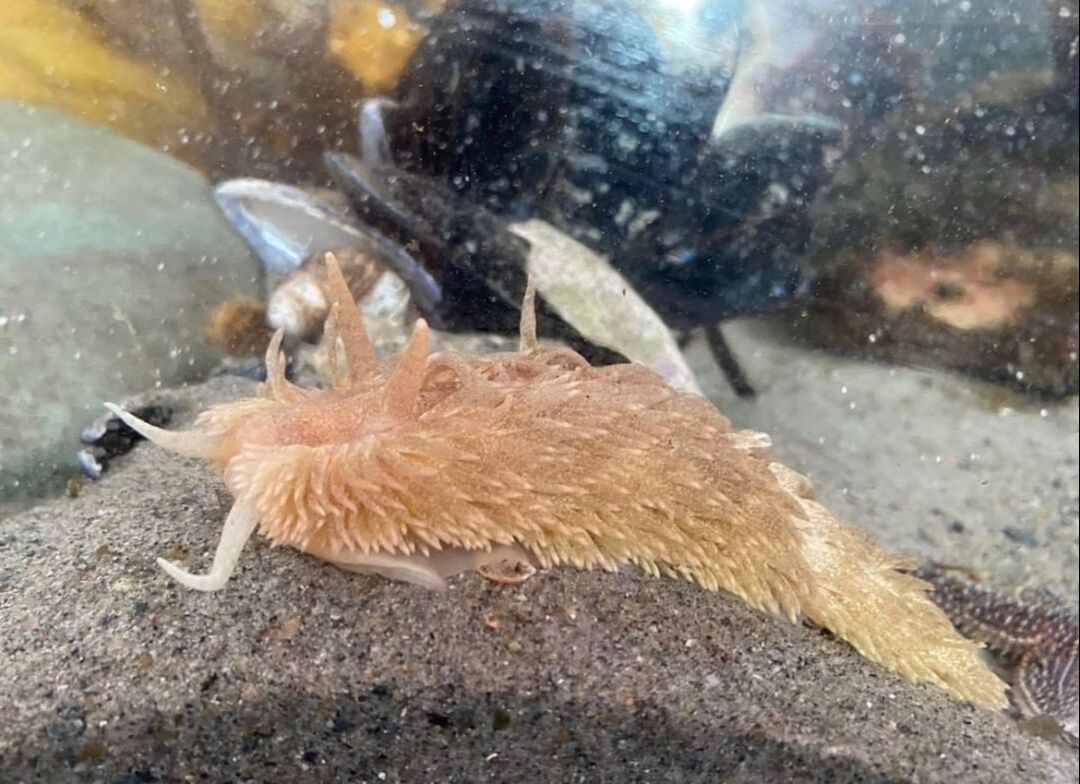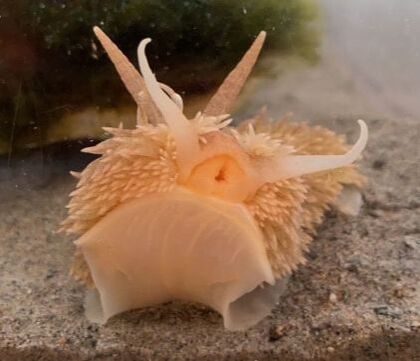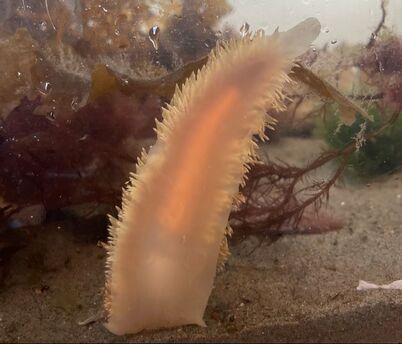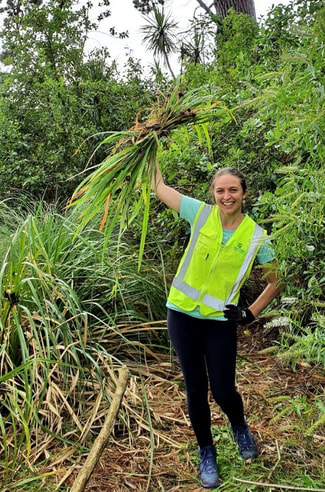 In the heart of Halifax, nestled against the picturesque backdrop of the Atlantic Ocean, a passionate marine conservationist has been quietly making waves. Meet Emily Baker, an advocate for marine life and a dedicated volunteer with Back to the Sea Society. In this blog post, we dive into Emily's journey – from exploring the depths of the ocean to inspiring visitors at the Back to the Sea Centre! Hailing from Halifax, Emily embarked on a remarkable journey that led her to the enchanting world of marine invertebrates. Armed with a degree in Marine Biology from Dalhousie University, she delved deep into the study of marine life, particularly captivated by the intricate lives of marine invertebrates. "During my undergrad, I became interested in marine invertebrates – they are such a fascinating group of animals and are SO important to our marine ecosystems," Emily explains. Emily’s passion led her to the BIO (Bedford Institute of Oceanography), where she contributed to a benthic ecology lab focused on studying deep-sea corals and sponges that inhabit our offshore waters. "I got to see a lot of marine life that lives FAR below the 'blue blanket' that Back to the Sea aims to lift!" Emily enthuses. Seeking broader horizons, Emily ventured to New Zealand, earning a Master of Marine Conservation, and gaining a global perspective on marine conservation efforts. Returning to Halifax, her hunger for knowledge persisted, and she now pursues a PhD in Applied Sciences at Saint Mary's University, focusing on coastal restoration – a testament to her unwavering commitment to preserving and revitalizing our marine environments. Motivation: Igniting the Flame Although Emily's memory of her initial encounter with Back to the Sea might be hazy, her commitment to the organization remains unwavering. "I can't remember how I learned about Back to the Sea! [but] I do know that I volunteered for the first time in 2018, and I loved it! Since then, I've come back as often as I can, and I'm hoping to continue volunteering in the future," Emily recalls. A childhood fascination with touch tanks ignited her desire to contribute to an organization that brings the wonders of the ocean to life for both locals and visitors alike. With Nova Scotia's rich maritime history intertwined with the ocean, Emily recognizes the importance of fostering a deeper connection between the community and its marine heritage. Volunteer Experience: A Touch of Wonder At Back to the Sea, Emily has found her niche as a touch tank interpreter, a role that allows her to share her passion and knowledge with a diverse range of individuals. "My volunteer role has primarily been as a touch tank interpreter - showing people the animals, answering questions, and sharing cool facts about the species they are seeing," Emily explains. Whether engaging with children, curious grandparents, lifelong locals, or inquisitive tourists, Emily finds immense joy in showcasing the marvels of ocean life. "One of the most rewarding aspects of my volunteer experience is when people ask if something in the touch tanks was really found right here in Nova Scotia - and I love watching the looks on their faces when I say 'absolutely yes!' Because I know that the next time they are at the beach, or near a tide pool, they will know what they might find," Emily shares with a smile. Personal Stories and Anecdotes: A Glimpse of Magic Among the countless anecdotes, one heartwarming tale stands out. "There are so many that it's hard to choose! Many visitors (of all ages) are initially hesitant to touch the animals, and then by the end of their visit they have touched everything! Being part of that shift is a lot of fun!" Emily chuckles. However, her favourite story involves a young hermit crab enthusiast: "A kid had come in who absolutely loved hermit crabs... both of us watched a hermit crab move from one shell to another one! Neither he nor I had EVER seen that before, so it was super exciting for both of us. And it was wonderful to see a kid's patient observation skills rewarded by Mother Nature!" Conclusion: A Sea of Possibilities Emily's journey from studying deep-sea corals, to inspiring young and old minds at Back to the Sea exemplifies the power of education and community engagement in nurturing a love for marine life. Through her contributions, Emily continues to bridge the gap between the mysterious depths of the ocean and the eager hearts of those who seek to explore its wonders. Inspired by Emily's story? We invite you to join the Back to the Sea family and embark on your own voyage of discovery. Together, we can lift the 'blue blanket' that veils our marine treasures and empower generations to come. Reach out to our Volunteer Coordinator at [email protected], or apply to volunteer using the form on our website!
3 Comments
Written by Laurel Dykun I’d like to introduce you to one of my favourite marine species, the Northern Bottlenose whale (Hyperoodon ampullatus). While they look like a very large Bottlenose dolphin, this cetacean is actually a species of beaked whale that lives in the North Atlantic. These whales are medium in size (for a whale), reaching around 10 metres in length at maturity. Northern Bottlenose males have a peculiarly large forehead, called a melon, that is very flat or square shaped. Females and juveniles have a smaller, more rounded melon. Males also have a single pair of erupted teeth, while the females’ teeth stay embedded in their jaw. It’s believed that males use their teeth in combat to fight for potential mates. Beaked whales are often cryptic and elusive, making them difficult to study. There is still a lot of mystery surrounding how these whales live. However, Northern Bottlenose whales are known to be curious and approach vessels more frequently than other species. Northern Bottlenose whales are extremely deep divers, with the ability to dive 1500 metres plus below the surface, going under for up to 130 minutes! While diving, they hunt for their prey of choice, squid. Since they don’t have teeth like a dolphin would, they use a sucking motion to slurp their food into their beak, like a big spaghetti noodle! These whales live in highly social groups and communicate with one another using a variety of clicks, and sounds. Instead of relying on eyesight when hunting, they send out a series of high frequency clicks called a ‘click train’ to locate their prey. These sonar pulses bounce off their target, making it easy to find them in complete darkness. On a spectrogram, these can be visually seen as the classic beaked whale ‘upsweep’. In Canada, Northern Bottlenose Whales are listed as endangered under the Species at Risk Act, and as near threatened on the IUCN (International Union for the Conservation of Nature) red list. The best-known location of these whales is in the Gully, a large submarine canyon off of Nova Scotia, and one of Canada’s Marine Protected Areas (MPAs). This population, and the newly discovered populations off Labrador, are the focus of Dalhousie University’s Whitehead Lab.
Written by Laura Eamon Depending on who you talk to, the Atlantic bluefin tuna (Thunnus thynnus) can grow up to 13 feet, 2000 pounds, and 40 years of age. Bluefins are the biggest and fastest of all tuna species. That’s not the only thing that makes them special. Atlantic bluefin tuna are also one of the only warm-blooded fish and the most migratory of all fish! 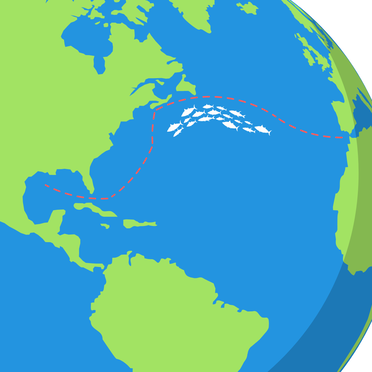 True snowbirds, the bluefins spend summers here in Atlantic Canada and have been known to spend their winters in the Gulf of Mexico, migrating north to south. However, bluefins have also been known to move west to east into the Mediterranean Sea. Some say these tuna can travel around 10,000 kilometres in just one year. That’s almost Nova Scotia to British Columbia and back! Tuna can’t actually breathe unless they’re swimming, so it makes sense they go so far. To help with their swimming, their bodies are built for speed and endurance. Atlantic bluefin tuna can retract their dorsal and pectoral fins into little slots, and their eyes are set flush to their bodies. All of this means these big fish can move really fast, shooting themselves through the water at up to 70km per hour. Known for their speed, the word tuna is derived from a Greek word meaning “to rush”. From the moment they hatch, Atlantic bluefins are on the hunt for a feast. Juveniles feed on smaller fish, crustaceans, squid, and eels, while adults feed mainly on bait fish such as herring and mackerel. Though they’re big, strong, and fast, these tuna can end up as prey for sharks, marine mammals, and other large fish. Their scale colourings help camouflage them from above and below with metallic blue on top and shimmering silver-white on bottom. Atlantic bluefin tuna are a top predator in the ocean environment, so they are very important in maintaining balance in their ecosystem. Overfishing and illegal fishing have been the main cause of endangerment for the species, but things are starting to look up! Public awareness campaigns by NGOs and the rise of the sustainable seafood movement have incentivized businesses to engage in better fishing practices. Most recently, the international agreement on catch quotas is now purely based on ecological science and research. We are so lucky to have these incredible creatures visiting the waters so close to us here in Mi’kma’ki. We are also thankful for the accessible information from organizations National Geographic, World Wildlife Federation, NOAA, Nature Conservancy of Canada, DFO Canada, and Ocean Conservancy.
 Written by Laura Eamon March 18 marks Global Recycling Day, and we’d like to take some time today to dive a little deeper into the three R’s: reduce, reuse, and recycle. REDUCE Up first is the most important and impactful R: reduce. Reducing our overall consumption, specifically in the global north, is the strongest way to make a positive change personally. Always buying brand new and more than you need takes a heavy toll on the environment *and* your wallet! Setting budgets, being mindful with your purchasing decisions, and using up what you already have are great ways to reduce your consumption. There are many online groups, books, and blogs about doing a year or month of buying nothing. Reading and sharing about these experiences can be super helpful for those who may find it difficult to reverse their consuming behaviours or don’t know where to start. Some people use the word “refuse” instead of or alongside “reduce” when reciting the three R’s. This is a helpful reminder when it comes to outings like restaurants or parades. You can refuse things you don’t need like plastic straws and cutlery or branded giveaways like pens or stickers. There’s a movement around the world toward a zero waste lifestyle, and we are so lucky to have stores like The Tare Shop right here in Dartmouth. This alternative way of business involves zero packaging where customers bring their own empty containers to refill what they need! REUSE Here’s where creativity and innovation really shine! Reusing materials is such an easy and fun way to extend the life of our goods. You can start at home by finding new uses for old items, like turning worn t-shirts into rags and bringing your own bags to the supermarket. You can make beautiful, unique jewelry out of beach plastics or sensory toys from packaging boxes. You can also be a superstar in helping others reuse the items you’d like to part with! There is an incredible community online called Buy Nothing Canada with each neighbourhood having their own closed Facebook group. Search online to find what treasures you can find for free from others, and post items you’d like to get rid of. I’ve even given away opened boxes of products I tried and didn’t like. Shopping second hand is a great way to get more use of products already out there. RECYCLE If we reduce our consumption and reuse our items for as long as we can, we shouldn’t end up with that much waste. However, there’s no one true way to live a perfectly zero waste lifestyle, so it’s important to practice good waste management at home and in our communities. If you do have household waste to go out on recycling day, make sure to use What Goes Where, HRM's waste management app and website in which you can look up items to determine where they should end up! Check it out at Halifax.ca. You can also take a look at seven questions we need to ask ourselves to ensure we create households and communities which recycle as responsibly as possible from Global Recycling Day. Some people might find themselves doing a spring clean and trying to get rid of many items in their homes at one time. It’s important to note donating bags of items in bins or big charity shops isn’t always a sustainable option. A lot of these items end up getting sent overseas to the global south and making a hugely negative impact on the environment and people there. While this blog post focused on individual efforts in reducing, reusing, and recycling, we acknowledge there are bigger organizations globally who have the ability to make bigger moves with bigger impacts. It’s important for all of us to take steps toward a more sustainable, healthy future!
Written by Laura Eamon If you’ve ever visited the Touch Tank Hut or been on one of our Tidal Trekker excursions, you would be familiar with the well known common sea star (Asterias rubens)! But did you know we have another star-shaped marine critter living in our ocean? The daisy brittle star (Ophiopholis aculeata) is closely related to the sea star, but they have some peculiar differences in their appearance and the way they live in their marine habitat. Let’s "star"t where these two species are similar: they’re both echinoderms (from the Greek echin, meaning spiny, and derma, meaning skin). This means they have a hard, spiny covering or skin. It also means their body parts are arranged around a central point like a wheel or a star! When overturned, echinoderms can right themselves back up. They have a unique vascular system that branches into their tube feet! Now let’s dive into some of the specifics. 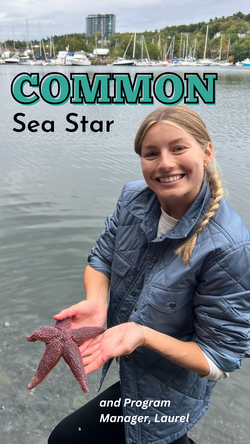 THE COMMON SEA STAR (Asterias rubens) The common sea star, so sweet and unassuming to the eye, is actually a major predator in rocky subtidal ecosystems, like the ones found along the Atlantic coasts of Nova Scotia and Newfoundland. MOVEMENT The sea star can rest stationary on rocks or creep along slowly as its tube feet extend, grip, release, extend, and grip again. Even though the bottoms of those little tube feet resemble a suction cup, the gripping is actually the result of adhesive chemicals. Impressively, sea stars can move forward no matter what part of their star shaped body is pointed that way! Sea stars show the strongest response in righting themselves after being shifted upside down. Like little gymnasts, they use their tube feet and arms to perform a slow, graceful somersault to restore their normal position. FEEDING The tube feet along the sea star’s five arms are used for so much! They help move around, but they are also important for feeding. Sea stars use their tube feet to tightly grasp their prey, which is usually molluscs like mussels or clams. Get ready for the gross part! The sea star then turns part of its stomach inside out through its mouth and into the narrow opening between the halves of its prey’s shell. The digestive system of the sea star releases juices that begin digesting the mollusc inside its shell. The stomach is then brought back inside the sea star’s body where digestion of the mollusc's now liquefied body is completed. Because of this intricate feeding process, sea stars can consume prey much larger than its little mouth! Get this: sea stars actually eat ophiuroids like the daisy brittle star. THE DAISY BRITTLE STAR (Ophiopholis aculeata) Brittle star species are found at all depths worldwide. Ophiopholis aculeata is found mainly in subtidal areas down to ~300m depth but has been reported down to 2250m! They may dwell on rock, sand, mud, live in burrows, or be anchored to other organisms such as sponges and corals. MOVEMENT Brittle stars may still be shaped like a star with five arms, but their bodies are much different than common sea stars. Where a common sea star might resemble a drawing of a Christmas tree star topper or the bright yellow star emoji, a daisy brittle star has a thick central disc and five long, flexible (read: squiggly) arms. Because of this, they are the most agile of echinoderms, taking long strides by lashing their arms like little snakes instead of inching along. The tube feet of a brittle star don’t match the tube feet of a sea star: they’re missing the suction-cup-like ends. They still release adhesive chemicals though, so they can grip underwater surfaces. In shallow water, brittle stars will hide their central disc,and expose only their flowy arms outside the shelter. Their centres generally remain concealed under rocks, in crevices, or among algae unless they’re escaping predation or reproducing. Known predators include the green sea urchin (Strongylocentrotus droebachiensis) and common sea stars (Asterias rubens), both of whom are frequent Touch Tank Hut regulars! We’ve got our job cut out for us keeping everybody fed and safe at Back to the Sea. FEEDING Brittle stars show all kinds of feeding behaviour. They are suspension feeders meaning they capture and ingest particles floating around in the water. These particles include phytoplankton, zooplankton, and bacteria. They can be detritivores, which means they feast on dead organic material. They can also show predatory behaviour feeding on crustaceans, bivalves, and even eggs! No matter who your favourite is, be sure to be respectful of all sea stars and marine life if you encounter them out in the wild or here at Back to the Sea's touch tanks! Visit this summer to sea some of these stars from the ocean at eye level. Sources
Written by Laura Eamon Last week, women and girls were celebrated across the globe for International Day of Women and Girls in Science. So many organizations posted online highlighting some of the incredible women-led projects and teams they’re proud of. This year’s Super Bowl even had their first all-female flight crew for the military flyover before the game. In 2020, Nova Scotia Health performed what might have been the first liver transplant with an all-female surgical team. In 2019, news broke from Lunenburg about possibly the first all-female lobster fishing crew on the south shore of Nova Scotia. These successes are so important to celebrate because it hasn’t always been this way, and we still have a long way to go. A significant gender gap has persisted throughout the years at all levels of science, technology, engineering, and mathematics (STEM) disciplines all over the world. Long-standing biases and gender stereotypes discourage girls and women away from science related fields. Women and racialized persons in science have experienced discrimination, harassment, and even personal harm. By keeping our diverse perspectives out of the science fields, research and innovation outcomes have been narrowed, limited, and lessened.
To combat statistics like the ones listed above, United Nations has declared February 11 International Day of Women and Girls in Science. This year’s theme was IDEAS - Innovate, Demonstrate, Elevate, Advance, Sustain: Bringing everyone forward for sustainable and equitable development. Women, racialized persons, and gender diverse people can help translate knowledge between science and society. Gender equality and the empowerment of women and girls will make a crucial contribution not only to economic development of the world but to progress across all the goals and targets of the Sustainable Development Goals. The process of how we conduct research is just as important as the results of the research. As the Events and Communications Coordinator, I am not directly involved in the scientific process of operating Back to the Sea. However, I get to dabble in the art and social science of marketing, fundraising, and economics. I also get to work alongside incredible volunteers and staff who have so much knowledge and experience to share. I spoke to a couple of women involved with Back to the Sea to celebrate science, and it was so validating and special to hear from them. Keep reading to find out why! Kaitlin (Communications Committee) told me, “Before, I thought the only way you ‘do’ science was to make a career out of it. I am excited to say that there are many ways to ‘do’ science.” She loves volunteering, reading, and being wowed by science in her daily life. To celebrate science, she recommends staying involved and staying curious. When asked why it’s important to have women on the team, Rachel (Communications Committee) said, “Equality in the workspace adds more perspectives which reduces the possibility of bias and conflict.” She supports other women and girls by telling them they don’t need to have a linear career. “Once you get your feet wet or your hands dirty, the learning never stops, and you never know where your next adventure can take you.” Laurel (Program Manager) has been a mentor for girls in science programs, and she says, “It’s so important for young women to have real-life role models to look up to and show them what they are capable of accomplishing.” She points out the huge drop in the number of girls interested in science once they hit teenage years, so Laurel has a strong message of hope for these young women: “if you find science fascinating–even if it’s hard–stick with it, and explore all the different facets of the subject. Let’s work to bring into the spotlight, highlight the impact, and promote the contributions and research outcomes of female scientists. If you’re a woman working within STEM, give strength and knowledge to the girls out there looking for inspiration. Tell us how your job is STEM related and what it means to you to be involved. Sources Inequality in science and the case for a new agenda | PNAS Women in science: Materials 2021 - Archive ouverte HAL International Day of Women and Girls in Science | United Nations
Written by Laura Eamon As we look ahead to welcome visitors in 2023, it is important to reflect on the past. Take a swim with me down memory lane to a sunnier, warmer time.. the summer of 2022. After a year of closed hut doors due to the pandemic and a pivot to online ocean education, we excitedly returned to the Dartmouth waterfront in our shining turquoise Touch Tank Hut at the beginning of July 2021. With a more flexible season on the horizon, we prepared for an even greater 2022! Throughout the 2022 season, we welcomed over 3,200 visitors, bringing the ocean to eye level. While most of our guestbook signers were from Nova Scotia, we were lucky to have visitors from all over Canada and beyond. Hands from Australia, Thailand, and India held local ocean critters! Minds from England, the Netherlands, and Germany learned incredible ocean facts. Smiles from the Philippines, Slovenia, and South Korea were stretched across visiting faces. Nova Scotian residents came in from 24 different communities and signed our guestbook. Canadians from Ontario, Alberta, Quebec, New Brunswick, Saskatchewan, British Columbia, Newfoundland and Labrador, and Manitoba all left their mark in our guestbook too! Imagine if all +3,200 visitors left us a message–think of all the places and people and faces. Next time you visit, make sure to sign our book, leave us a note, and be an engaged part of our community. We are so thankful for all the support; from likes and comments on social media to spending time with our staff at the tanks, from helping release our collected marine life back to the sea to outbidding your pals in our ‘Tis the Sea-son Auction. A dollar here, an hour there–any support is monumental in bringing our dream of a permanent community aquarium to life. We could not bring the ocean to eye level and spread ocean optimism without our incredible volunteers. Tank you so much! We also could not have had such a fin-tastic summer sea-son without our whaley talented staff, Sam W., Sarah H., Shwayam V., Haylie L., Lindsey W., Laurel, D., and our Founder, Magali! Back to the Sea is so lucky to keep picking the best fish in the sea when it comes to employees! So here’s to another summer of fun and hands-on learning, Dartmouth, Halifax, and beyond. We’ll sea you in 2023.
Written by: Lindsey Wamboldt Winter is the perfect time to bundle up and get together with your friends and loved ones. With this in mind, we wanted to highlight some of the ocean's coolest animal friendships! Starting off with a pairing that may be familiar to some - clownfish and sea anemones! Seen in the Disney/Pixar classic, Finding Nemo, and often used as a fun-fact found floating around the Touch Tank Hut, these animals are best buds! These two animals have a symbiotic relationship, which means the animals exist together in a way that benefits them all (Collins). Clownfish are able to swim through the stinging tentacles of sea anemones unharmed due to a mucus coating that covers their skin. Living in the sea anemones offers them protection from predators in the open ocean. The sea anemones also benefit as the movement of the clownfish brings fresh sea water through its tentacles, thus providing it with oxygen! Photo from: https://twofishdivers.com/blog/marine-symbiosis/ Our next pair certainly understands team work! Gobies and blind shrimps work together to create a safe burrow in the sand. The gobies are fierce protectors and will keep an eye out for predators while the blind shrimp digs the burrow! If the goby sees a threat, it will alert the shrimp and they will take cover. After the burrow is built, the goby will continue to protect its friend, the blind shrimp, and make sure the coast is clear whenever the shrimp goes out of the burrow to eat. Our final pair really works together to keep each other healthy. Sharks and remora fish are definitely an unlikely pair, given that sharks would usually eat fish of their size! Remora fish will suction on to the underbelly of a passing shark and eat pieces of prey that the shark leaves behind! They also gain protection from other predators because no one wants to mess with a shark! The remora fish will eat parasites off of the shark's skin that would hurt the shark otherwise. What a good friend! Photo by: Cat Gennaro (https://www.discovery.com/nature/sharks-and-their-interspecies-friendships-pictures) Whether big or small, predator or prey, ocean friends work together to keep each other happy and safe!
By Laurel Dykun Today is Fibonacci Day! The day we celebrate the Fibonacci Sequence, a pattern of numbers in which each number is the sum of the two before it - 1, 1, 2, 3, 5, 8, 13 - and so on. It’s named after the Italian mathematician, Leonardo of Pisa, later known as Fibonacci. The sequence can be found in mathematics, architecture, stock-trading, and even in nature! One of the most interesting animals that has the Fibonacci Sequence in its biological design is the nautilus. The Fibonacci spiral drawn in a rectangle (right) and Leonardo of Pisa (left) Image credit: Stefano Bianchetti via Getty Images Meet the Nautilus Nautiluses are marine molluscs of the cephalopod family, think squid with its ‘shell’ on the outside! They are a link to the past and have been around for over 480 million years, swimming the ocean depths before even dinosaurs were around. Today, nautiluses are native to tropical Pacific waters. Unlike other cephalopods like squid or octopus, nautiluses have very poor eyesight, only able to sense how light or dark their surroundings are. Instead, they rely on their strong sense of smell to find food and potential mates. A chambered nautilus (Nautilus pompilius) Image credit: Monterey Bay Aquarium To protect itself from predators, the nautilus can close itself completely inside its shell by shimmying inside and shutting an exterior ‘door’ called an operculum. In turn, they are able to hunt small fish and crustaceans by using jet propulsion to move around the water column, and by using their sticky tentacles (they can have over 90!) to grab onto their meal. Once caught, the nautilus uses their beak-like mouth to chow down. A crusty/fuzzy nautilus (Allonautilus scrobiculatus) Image credit: Peter Ward Cool! But, Where is the Fibonacci Sequence? Were you able to spot it? It’s actually seen in the nautilus’ shell! The spiral curve of the shell follows the pattern of a spiral drawn in the Fibonacci rectangle. This type of spiral is known as a logarithmic spiral and the nautilus is a prime example of its use in nature. Image credit: Math Images Conservation Nautilus shells are coveted for their beautiful appearance as well as the mother-of-pearl substance that lines the inside of it. Since these animals mature late and don’t produce many offspring at a time, shell collecting can mean a significant decline in nautilus populations. Because of this, many organizations stopped selling nautilus shells. And in 2017, the chambered nautilus, which is particularly collected for its shell pattern, was listed as threatened under the Endangered Species Act. Fun Facts!
By Sarah Holleran This past season at the Touch Tank Hut, we welcomed a new animal we haven't had before; a maned nudibranch (Aeolidia papillosa)! Let's take some time to learn about this fin-tastic animal and why we at Back to the Sea think it is so claw-some. Touch Tank Hut's maned nudibranch out for a stroll Nudibranchs (pronounced NEW-dee-bronk) Many visitors at the Touch Tank Hut, including myself, are intrigued by the nudibranch, commonly known as the sea slug. These animals are soft-bodied, shell-less marine molluscs. You will often see our nudibranch at the bottom of our tanks, cruising over sand and rocks. Nudibranchs can be found at the bottom of shallow waters in all of the world's oceans, feeding on other invertebrates, particularly sea anemones. They feed using their radula, which is comparable to a spike-y tongue. While eating sea anemones, nudibranchs also soak up their prey's pigment into their tissue, which allows them to camouflage from predators. Nematocysts, or 'stinging cells' are a common feature on sea anemones and they are ingested by nudibranchs and used for defence purposes. They can be found on the outgrowths on nudibranchs called "cerata". Up close and personal with our maned nudibranch Nudibranch Love Nudibranchs, just like snails, are hermaphrodites, which means they have both male and female reproductive organs. For nudibranchs to reproduce, they can mate with any other mature nudibranch that is the same species as them. While doing a dance-like courtship, sperm is exchanged from both partners where it is stored until the eggs are ready for fertilization,. The eggs are then laid by both nudibranchs in a unique spiral formation. Shortly after we obtained our lovely nudibranch, it laid eggs in our tank. At first, they were a big surprise to staff members as we had never seen anything like this in our tanks before. After doing some research, we found out that our nudibranch had laid eggs around our tank. It was exciting to show visitors and volunteers, since many people have never seen a nudibranch in real life before, let alone nudibranch eggs (me including)! 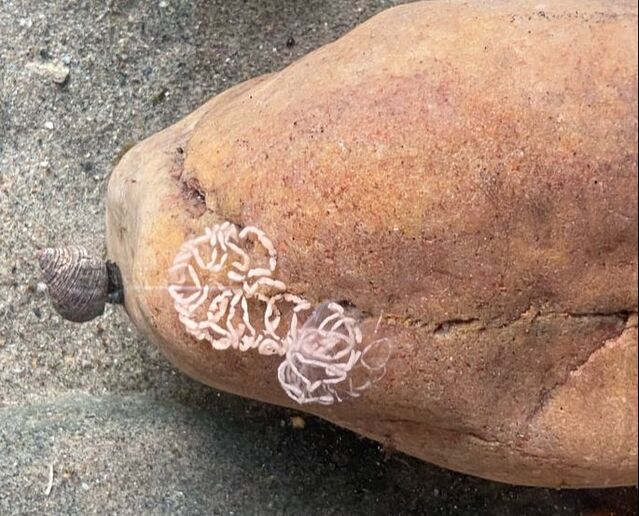 Nudibranch eggs next to a periwinkle at the Touch Tank Hut Chemical Communication Nudibranchs have another extremely fascinating thing about them - they are strong communicators! Just like snails, nudibranchs leave a trail behind them as they crawl along the ocean floor (or our touch tank). The trail they leave behind is filled with chemicals and nudibranchs use this to communicate with others. The trail can tell other nudibranchs about a potential danger, or help to attract a potential partner. When it comes time to finding their food or a mate, nudibranchs use their rhinophores which are sensory organs or tentacles found on the back of the head or neck. These are also found in animals such as sea hares. Nudibranch sliding down the tank glass Sea it Yourself! As you can see, nudibranchs are amazing marine animals and we were so happy to have one living at the Touch Tank Hut for the 2022 season. You might even be able to see one for yourself in shallow area between kelp fronds! Keep your eyes on the water! |
Categories
All
We send blog recaps with in all our quarterly newsletters!
|
